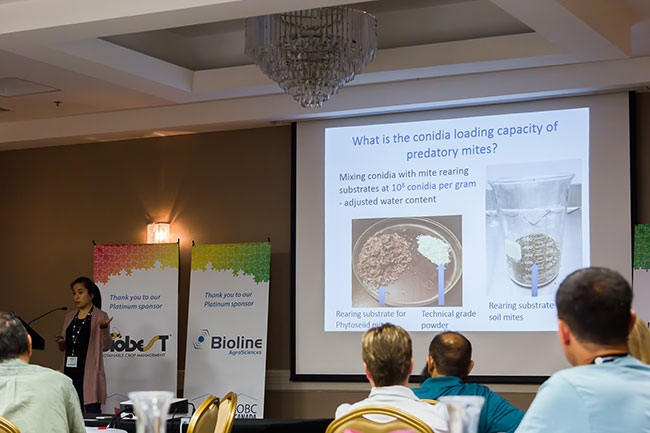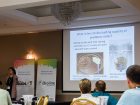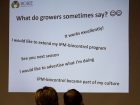
Features
Biocontrols
Inputs
Discussing The Latest IPM Tools
Leading pest management specialists offer updates during the “International Organization for Biological Control” Working Group Meeting in Niagara Falls
August 31, 2017 By Dr. Sarah Jandricic
 Gongyu Lin from the University of Montreal demonstrates her research on using predatory mites to carry Beauveria spores to infect western flower thrips. Photo courtesy of Maryna Kaliuzhna, Institute of Zoology, Ukraine.
Gongyu Lin from the University of Montreal demonstrates her research on using predatory mites to carry Beauveria spores to infect western flower thrips. Photo courtesy of Maryna Kaliuzhna, Institute of Zoology, Ukraine.September 2017 – I’m sure growers sometimes wonder what the heck scientists are doing behind closed doors all day in our labs and research greenhouses. Since it often takes several years of repetitious experiments to conclusively find an answer to a problem (or even longer to bring a new product or process to the market), I’m sure that, from the outside, it sometimes seems like things are at a standstill.
But based on the research presented at the “Integrated Control in Protected Crops” (IOBC) Working Group Meeting in Niagara Falls in June, the greenhouse research community is working hard to bring you solutions to your pest problems. And, there are some exciting things coming down the pipeline.
Overall, I was incredibly impressed at the real-world applicability of the research being done by the 130 scientists from over 15 countries in this Working Group.
Highlighted here are just a few tips, tricks and interesting research results that came out of the meeting, so you can get a feel for what researchers are up to lately. For regular research updates, subscribe to Ontario’s Floriculture Blog (ONfloriculture.wordpress.com).
Determining Which Control Measures to Use Seasonally (The “WHAT” and the “WHEN”): Determining the right IPM tool for the job, and knowing when to integrate it into your program is vital. This information can help explain control failures, save money (since less inputs may be more effective at different points in production), and generally help us narrow down the IPM “recipe” for certain crops or pests.
A pertinent example of this is continuing research on whitefly control. Dr. Rose Labbe (AAFC-Harrow) gave a fascinating keynote address summarizing known environmental effects on biocontrol agents, including whitefly natural enemies. Researchers have determined that parasitoids like Eretmocerus don’t perform well from January to April, due to low temperature and light levels. My work with Ontario growers suggests that the predatory mite Amblydromalus limonicus may be able to fill this niche in some crops, as it functions better than other available natural enemies in cool temperatures. Dr. Andreas Walzer, a researcher from Vienna, thinks that Limonicus could also be effective for whitefly in summer, as long as the daily maximum temperature of the greenhouse doesn’t go above 40 C. Limonicus may soon be available in sachet form, which could open up a whole new possibility of year-round uses with this natural enemy.
Of course IPM is not just about natural enemies – pesticides are a key tool, too. Steven Arthurs from the University of Florida discussed the fast-growing market for microbial pesticides (a $1.25 billion dollar industry in North America), many of which are certified for organic production. Interestingly, he reported that over 80 per cent of biopesticides used in North America are used in fruits and vegetables. Perhaps it’s time for ornamental growers to catch up and see where and when we can best take advantage of this growing set of tools.
We also have a lot to learn about what to apply when from the growers themselves. This was obvious during the Grower Session of the meeting (with over 50 local growers in attendance). For example, Blake Fisher from Boem Berry Farm outlined how current IPM programs developed in the Netherlands for greenhouse-grown strawberries don’t necessarily translate to Ontario conditions. Growers are having to come up with their own solutions through good old-fashioned trial and error.
Better Application Strategies (The “HOW”): Improving application strategies for biocontrol agents was also a major theme at the meeting, in order to increase their efficacy and give you more bang for your buck.
Dr. John Sanderson from Cornell University is looking into various species of nematodes and cultural practices for better fungus gnat (Bradysia impatiens) control. He demonstrated that, under ideal conditions, you can continue to get >75 per cent mortality of fungus gnats with S. feltiae for up to eight weeks after an initial drench application. However, this might be affected by irrigation methods. His early results suggest that sub-irrigation leads to better fungus gnat mortality, since it’s less likely to wash the nematodes out of the pot than overhead irrigation. He’s currently continuing tests to confirm this.
Dr. Michael Brownbridge, from the Vineland Research and Innovation Centre, has been looking at the use of foggers (a.k.a., low-volume machines, or LVMs) to improve coverage – and potentially, efficacy – of microbials for insect and disease control. But he’s found that not all LVM machines are appropriate for all microbials (these ARE living organisms after all, with different requirements and tolerances). Thermal fogging with a K-22 BIO Portable PulsFOG®, though suitable for a product like Cease® (Bacillus subtilus), unfortunately killed up to 90 per cent of Beauveria bassiana spores. This is likely due to more heat/energy than the Beauveria spores can handle being generated during the fogging process. Testing is ongoing to figure out if this machine can be modified to mediate these effects.
Agrobío, a biocontrol company from Spain, is looking at adding food mites (like the ones already in mite sachets) directly to plants as an additional food source for A. swirskii and other predatory mites. Their method not only led to increased predatory mite counts on leaves, but also improved control of western flower thrips in a variety of greenhouse crops. This could definitely be an interesting and unique new option to boost a thrips IPM program.
Ronald Valentin from BioLine, one of our keynote speakers for the Grower Session, had a neat tip for those of you using trap plants for thrips and other pests (i.e., plants more attractive to the pest than the crop plant). When initially setting up your trap plants in the crop, place an open garbage bag under them. This way, when you go to remove the plant, you can just slide the bag around it, reducing the risk of distributing pests gathered on them.
Tackling Industry Challenges (the “WHY, OH, WHY”?!): Not surprisingly, there were several talks on pepper weevil (Anthonomus eugenii), an insect that’s been the bane of pepper growers in Canada for the past year. This pest burrows into buds and causes premature fruit drop, resulting in economic losses of up to $23 million in the U.S.
Researchers at AAFC Harrow, OMAFRA and the University of Windsor are busy looking for natural enemies for pepper weevil; several promising parasitoid species have already been identified from local weevil populations. The next step they’re working on is to see if these parasitoids can be reared effectively for augmentative release.
Another industry challenge that isn’t going to be resolved any time soon is successful integration of biological control agents and pesticides, without detrimental side effects. One piece of food-for-thought that came out of our discussions? Perhaps it’s time for us to re-evaluate IOBC guidelines that govern pesticide compatibility and natural enemies, or at least our interpretation of them. After all, a pesticide classified as “harmless or slightly harmful” in some online databases can still cause up to 25 per cent losses of a natural enemy in lab trials, and up to 50 per cent losses in field trials, according to the current guidelines. That’s a lot of bios you could be losing! And this doesn’t necessarily take into account sub-lethal effects on the population, like lower searching efficacy, or decreased reproduction, that can also derail a biocontrol program. We’ll see where the future takes us on this particular issue.
Research and YOU (the “WHO”): Pulling off a scientific meeting of this size required joint effort from members of the Ontario Ministry of Agriculture, Food and Rural Affairs; Vineland Research and Innovation Centre; Agriculture and Agri-Food Canada; Flowers Canada Ontario; University of Guelph; Cornell University; and several private companies (BioLogical Solutions, Ecohabitat Agri Services and Biobest).
We also couldn’t have made this happen without some very generous sponsors (see IOBCCanada2017.ca for the large list).
But the unsung heroes of this meeting are the growers around the world who not only bring us interesting challenges and questions relating to pest management, but also consistently open their doors to researchers so we can do on-farm, proof-of-concept trials. Without you, none of this important work would even be possible.
Dr. Sarah Jandricic is the greenhouse floriculture IPM specialist for OMAFRA. She is responsible for IPM for insects and plant diseases and conducts on-farm research trials in collaboration with growers. She can be reached at sarah.jandricic@ontario.ca, or 905-562-4141 – ext. 106.
Print this page


